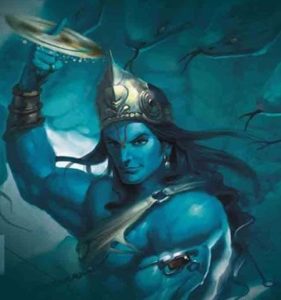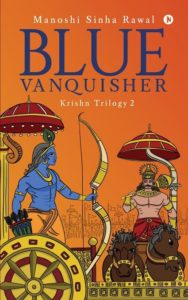Is Krishna a historical or mythical character? There have been ample debates and discussions on this topic. Evidences, both archaeological and written, prove him as a historical figure. Archaeological evidences affirm Dwarka as the ancient kingdom ruled by Krishna. Excavations done mainly at two sites led to the discovery of submerged settlements in the form of exterior and interior walls, fort bastions, and remnants of an entire city. Besides, finding of triangular stone anchors with three holes prove it was a well-planned city with an advanced harbor.
Dwarka, which means ‘gateway to heaven’, is deemed a holy place for the Hindus; it is one of the Chardhams (the other three being Badrinath, Puri, and Rameshwaram) and also one of the Sapta Puris (the other six being Ayodhya, Mathura, Haridwar, Varanasi, Kanchipuram, and Ujjain).

Many reckon this ancient city of Lord Krishna as merely a myth. But ruins discovered under waters of the submerged city of Dwarka tell a different story. Yes Lord Krishna existed! The magnificent city of Dwarka existed. Mahabharata is a historical tale. The Mahabharata war did take place. It is believed the entire city of Dwarka that dates back to 5000 to 7000 years submerged under water owing to a catastrophe.
Krishna speaks about Dwarka, an excerpt from Blue Vanquisher: “Our kingdom will spread across Saurashtra, Kathiavad, and Sindh. Our capital shall be at Dwarka, located in an island in the sea. Jarasandh can never attack Dwarka. Our people will be completely safe there. They will stay in peace and contentment.”
A discovery of an ancient city in ruins dating back between 4000 to 6000 years under waters in the Arabian Sea in the Gulf of Cambay further proves the existence of the city of Dwarka mentioned in the Mahabharata. Krishna’s Dwarka spread across Saurashtra, Kathiavad, and Sindh. And the discovery of the city under the waters was between the mainland Gujarat and Saurashtra Penninsula.
In between 1999 to 2001, the National Institute of Ocean Technology (NIOT) conducted a survey in the Gulf of Cambay. Scientists and marine archaeologists came across excellent geometric objects below the sea-bed, similar to Harappan and pre-Harappan ruins.
The Hindu carried a report on this in 2001, which read thus, ‘Acoustic images showed the area lined with well-laid house basements like features partially covered by sand waves and sand ripples at 30-40 metre water depth. At many places, channel-like features were also seen indicating the possible existence of possible drainage in the area….Possible age of the finds can be anywhere between 4000-6000 years’ and that ‘the site might have got submerged due to a powerful earthquake’.
The results of the follow-up reports related to the research of the artefacts from the Gulf of Cambay at the Physical Research Laboratory – Ahmedabad, National Geophysical Research Institute (NGRI) – Hyderabad and the Birbal Sahni Institute of Paleobotany (BSIP) – Lucknow were stunning. These artefacts date back between 9000 to 12000 years. The piece of wood was carbon dated to be 9,500 years old!
Here is a short description about the ancient city of Dwarka – an excerpt from Blue Vanquisher: ‘Vishwakarma builds the golden city of Dwarka like heaven. No other palace and city is as grand, as incredible, and as magnificent as Dwarka. With the parijat flower trees on either sides of every lane, bylane, and roads, all the palaces are ornamented with precious jewels. Vishwakarma also brought to Dwarka the SuDharma, the administrative parliament building of heaven.’
According to a February 2007 report by The Hindu, the Underwater Archaeology Wing (UAW) of the Archaeological Survey of India (ASI) discovered ancient structural remains under water in the Arabian Sea. These ruins are situated 131 feet beneath the ocean surface in the bay of present Dwarka. They also found 30 copper coins from an excavated site on land close to the Dwarakadhish temple. This temple was originally built around 2,500 years ago. It was destroyed by Mahmud Shah in the 16th century and rebuilt soon after.
This survey in 2007 was conducted under the direction of Alok Tripathi, Superintending Archaeologist from UAW along with divers from the Navy and a team of Archaeology students from across the country.
A second round of excavations in Dwarka was done by the ASI in 1979 under the direction of S.R. Rao. They found distinct pottery of lustrous red ware. Datings of the pottery proved it to be more than 3000 years old. Further research under waters in the Arabian Sea began in 1981 which continued for 20 years. Archaeologists discovered fragments of granite structures, stones, beads, glass, and terracotta pieces besides the submerged city believed to be of Dwarka.
The Mahabharata finds mention about an air battle that took place in the skies of Dwarka between Krishna and Salva, the king of the Salwa kingdom with his capital at Saubha, not very far from Hastinapur. The fact that airplanes were discovered by ancient Indians holds true. There are several references and descriptions in the Mahabharata and other books that corroborate this statement. Here is an excerpt from Blue Vanquisher on this airplane battle in the Dwarka sky:
‘Salva attacks Dwarka with a huge army of soldiers, who are accommodated in his huge airplane, which looks like a tiny city on air above the ground. As the airplane flies over Dwarka in the sun, the area under it turns dark under the impact of its shadow.’
‘….. Releasing his arrows, Pradyumn severely injures Dyuman, Salva’s commander-in-chief followed by death of soldiers in the airplane in tens and hundreds one after another through sets of arrows.’
‘Seeing Krishn coming towards him, Salva releases a powerful weapon, which looked like a meteor, towards the blue warrior. The sky brightens up with its illumination. Krishn releases an arrow that hits Salva’s weapon on air, breaking it into multiple pieces.’
‘Krishn soon releases a shower of arrows towards Salva, but they fail to hit him. He then overpowers Salva’s airplane. From his Garuda, he jumps into the airplane. Salva immediately strikes Krishn on his left shoulder which resulted in the falling of the bow from the latter’s hand.’
‘Now Krishn is weaponless. Salva, surmising he is victorious, looks at Krishn sternly and shouts at the top of his voice. “I have been waiting for this very day, to strike you! You kidnapped Rukmini in our presence, baffling my bosom friend Sishupal. And then at Yudhisthir’s Rajsuya yajna, you treacherously beheaded him. Everyone considers you to be a warrior and a conqueror, but actually you are not! You will die in my hands today!”’
In this air battle, Krishna kills Salva.
The Krishna portrayed in many a book and the Krishna we know about and worship is not the real Krishna. His noble character has been stigmatized for long, portraying him as a lover, indulging in love-affairs with Radha and gopis. This is all false! Radha was his ‘Maami’; she was 10 years older to him. Radha was married to Ayaan, Yashoda’s brother.
Krishna was a multi-faceted, accomplished, and ideal personality, endowed with all virtues and free from all blemishes. He was a Yogpurush, the savior, the protector, the Supreme Being, and an efficient ruler. He was a doting son. My two books on Krishna from the ‘Krishna Trilogy’ series depict the story of Krishna from birth to death, delving on every aspect of his life besides refuting the many myths associated with him. The first book in the series The Eighth Avatar describes Krishna’s journey from birth till the fourteenth year of his life and the second book Blue Vanquisher from his 14th to 85th year.
Excavations at Dwarka are happening at a snail’s pace at counted few locations. The ASI should increase its speed so that more truth on the lost ancient city of India is unearthed.
Featured image courtesy: Pinterest and YouTube.
Ref:
1. Harappan-like ruins in Gulf of Cambay, The Hindu
2. New find to guage exact age of ancient Dwarka, DNA India
3. Significant finds at Dwaraka, The Hindu
4. The Eighth Avatar, Manoshi Sinha
5. Blue Vanquisher, Manoshi Sinha.









Leave a reply